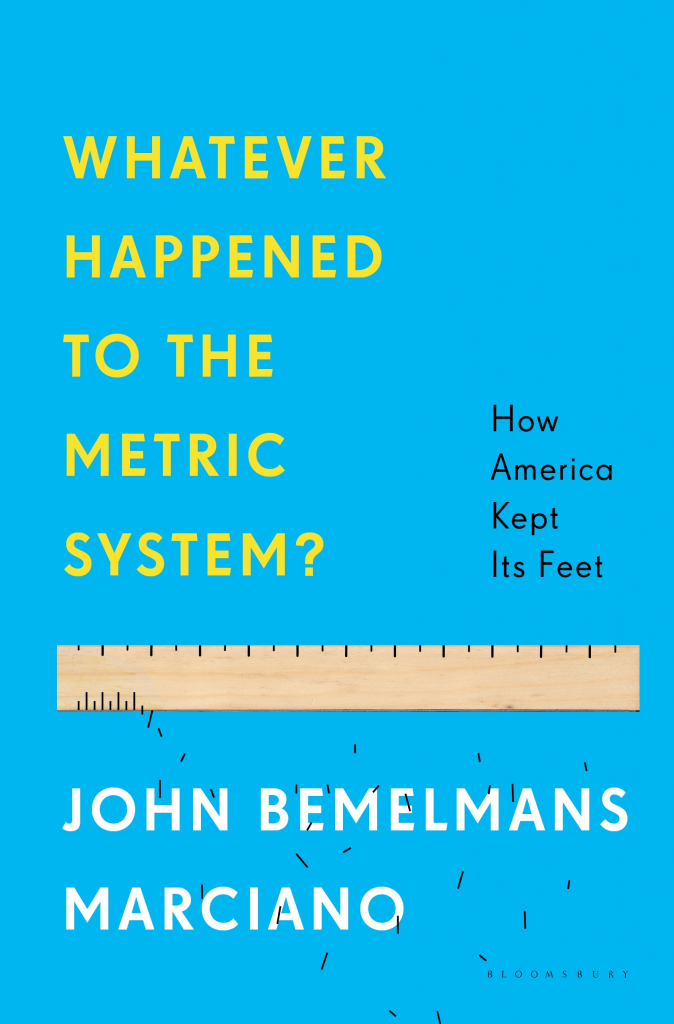
Whatever Happened To The Metric System? An Interview with John Bemelmans Marciano

Whatever Happened To The Metric System? How America Kept Its Feet
by John Bemelmans Marciano
(Bloomsbury, 2014, 310 pages, hard-cover with inset of colour and black and white photos)
Quick: Where were you the day the Metric System died in America?
Actually, it’s a trick (and tricky) question. For one thing, despite what the gas-station attendant pumping your gas in gallons would tell you, the metric system is very much alive in The U.S.A. Your medicine comes in metric doses (no one, on a long trans-Atlantic flight, asks for 1/18th of an ounce of Xanax), as does cocaine (in kilos), and soda (remember those famous 1970s “2-litre Pepsi ads”, where the kid knocks the bottle off the table in super slow-motion and the family is horrified—until the bottle doesn’t break! It bounces!) And if you’ve watched the Olympics or the World Cup (in Russia and Brazil, respectively), all of those sprints are measured in metric.
But then, we go about buying our pound of butter, gallon of milk, and sponsoring the neighbourhood kids in a “two-mile-Fun-Run” to cure cancer, reverting to our own weird American-only system of measurements.
John Bemelmans Marciano, who sat down with us to talk about his latest book in his Red Hook, Brooklyn home, has written what must be considered the definitive (and eminently readable) book on the metric system: Whatever Happened To The Metric System? How America Kept Its Feet.
“Actually, I wanted to do a full-on history of measurement, going back to the 1600s”, Marciano noted. However, like all authors who must work with a heavy-handed editor, his book begins in the late 18th-century, with a triad of Americans in Paris: Thomas Jefferson, John Adams, and the bon vivant of the Parisian salons, Benjamin Franklin.
Turns out that the Metric System is (or was) a lot more American than most of us ever gave it credit for. It was that renaissance man—architect, president, vice-president, secretary of state, University of Virginia Founder, and author—Thomas Jefferson who, per Marciano, really got the Metric System rolling, by (1) getting out of America and over to our newest ally, France (who hated Great Britain at least as much as we did), where a fetish to measure everything from the circumference of the earth to systemizing weights and distance and coinage was all the rage, and (2) coming up with a decimal system we still use today: our dollar currency (after all, our dimes, dollars, etc. are based on tens—nickels and quarters not withstanding).
Marciano says that the book took him “About four years to research and write” and I believe him; for what the book mercifully lacks in foot- or end-notes, there’s no question that Marciano has done his (and our) homework on The Measuring System That Almost Was.
And it’s a personal tale, too. Marciano, who is sorely stricken with tall, dark and handsome European good looks, and American fitness, was born the same year I was (and, for that matter, Luxe Beat Magazine Editor-in-Chief Sherrie Wilkolaski), 1970. This was the beginning of “The Decade of Nightmares” (to use Philip Jenkins’ title) and at the same time, “It Seemed Like Nothing Happened” (Peter N. Carroll’s title), and whatever else was going on (Watergate, the end of the Vietnam War, the hostage situation in Iran, Three Mile-Island), the Metric System was going to happen here, dammit! As President Gerald Ford famously boasted, “America is miles ahead when it comes to the metric system!” Yogi Berra could not have said it better himself.
Part of the charm of this book is Marciano’s balanced but not boring approach. He’s lived in France, Italy and Canada (all metric countries), and was raised on a farm in New Jersey (which is a foreign land, too, but not metric), so he has no proverbial, clichéd axe to grind. And in place of a lot of boring theories, he brings to life the men (and a few women) who fought over what system would eventually triumph.
In the fever-pitch of those 1970s salad-days, when the Schoolhouse Rock Saturday morning videos featured how “cool” the metric system was, one could have believed that we were going metric. After all, the U.S. had not only just adopted soccer—another completely foreign concept– but in creation of the New York Cosmos, featuring Pele, Carlos Alberto and Giorgo Chiellini, became “Cosmo-politan”. And soccer was (and is) measured metrically.
However, like many metoric rises and overnight successes, whether they be the Cosmos or the Metric System, most go into a shooting-star fall. In the case of the Metric System, President Reagan, to prove he wasn’t afraid to take axe to the Budget when it came to fat, decided to cut the U.S. Metric Association out of the government. Ironically, the USMA still exists—and is even growing—as a non-governmental agency. And once this was done, a lot of people started wondering aloud why, exactly, we needed two forms of measurement, especially if Uncle Sam wasn’t going to MAKE us do it.
But Marciano does a better job of summing this up, “I could never feel Celsius”. La mot juste.
In addition to epiphanies like this, the book produces a simply superb section of colour-plates and black-and-white photos, all of which are art-gallery quality. Further, the book, once you get used to its pace, really reads. After all, you start to wonder, “How on earth are we going to get from 1786 to 2014 in 300 pages?” Marciano does a masterful job.
This isn’t Marciano’s first time at the dance, far from it. He had success with two books on word origins, Anonyponymous and Toponymity, and prior to that, gave his grandfather’s (Ludwig Bemelmans) Madeline a whole new lease on life with Madeline and the Cats of Rome, Madeline Says Merci, Madeline at the Zoo, Madeline and an Old House in Paris, Madeline in America, and Madeline’s Tea-Party, all of which he illustrated as well. However, if you are waiting for Madeline And The Metric System—don’t hold your breath; “There will be no more Madeline books”, Marciano says.
Whatever Happened To The Metric System? is a revelation on a number of levels—perhaps most remarkably, it makes learning not only about the metric system itself, but crazy history behind it fascinating reading.




































